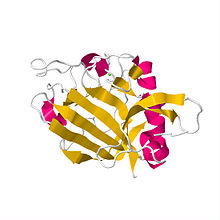| angiopoietin 1 | |||||||
|---|---|---|---|---|---|---|---|
| Identifiers | |||||||
| Symbol | ANGPT1 | ||||||
| NCBI gene | 284 | ||||||
| HGNC | 484 | ||||||
| OMIM | 601667 | ||||||
| RefSeq | NM_001146 | ||||||
| UniProt | Q15389 | ||||||
| Other data | |||||||
| Locus | Chr. 8 q22.3-8q23 | ||||||
| |||||||
| angiopoietin 2 | |||||||
|---|---|---|---|---|---|---|---|
 Crystal structure of the human angiopoietin-2 receptor binding domain.[1] | |||||||
| Identifiers | |||||||
| Symbol | ANGPT2 | ||||||
| NCBI gene | 285 | ||||||
| HGNC | 485 | ||||||
| OMIM | 601922 | ||||||
| RefSeq | NM_001147 | ||||||
| UniProt | O15123 | ||||||
| Other data | |||||||
| Locus | Chr. 8 p23 | ||||||
| |||||||
Angiopoietin is part of a family of vascular growth factors that play a role in embryonic and postnatal angiogenesis. Angiopoietin signaling most directly corresponds with angiogenesis, the process by which new arteries and veins form from preexisting blood vessels. Angiogenesis proceeds through sprouting, endothelial cell migration, proliferation, and vessel destabilization and stabilization. They are responsible for assembling and disassembling the endothelial lining of blood vessels.[2] Angiopoietin cytokines are involved with controlling microvascular permeability, vasodilation, and vasoconstriction by signaling smooth muscle cells surrounding vessels.[3] There are now four identified angiopoietins: ANGPT1, ANGPT2, ANGPTL3, ANGPT4.[4]
In addition, there are a number of proteins that are closely related to ('like') angiopoietins (Angiopoietin-related protein 1, ANGPTL2, ANGPTL3, ANGPTL4, ANGPTL5, ANGPTL6, ANGPTL7, ANGPTL8).[5]
Angiopoietin-1 is critical for vessel maturation, adhesion, migration, and survival. Angiopoietin-2, on the other hand, promotes cell death and disrupts vascularization. Yet, when it is in conjunction with vascular endothelial growth factors, or VEGF, it can promote neo-vascularization.[6]
- ^ PDB: 1Z3U; Barton WA, Tzvetkova D, Nikolov DB (May 2005). "Structure of the angiopoietin-2 receptor binding domain and identification of surfaces involved in Tie2 recognition". Structure. 13 (5): 825–32. doi:10.1016/j.str.2005.03.009. PMID 15893672.
- ^ Alves BE, Montalvao SA, Aranha FJ, Siegl TF, Souza CA, Lorand-Metze I, et al. (2010). "Imbalances in serum angiopoietin concentrations are early predictors of septic shock development in patients with post chemotherapy febrile neutropenia". BMC Infect Dis. 10: 143. doi:10.1186/1471-2334-10-143. PMC 2890004. PMID 20509945.
- ^ Scott F. Gilbert (10 April 2010). Developmental Biology (Loose Leaf). Sinauer Associates Incorporated. ISBN 978-0-87893-558-1.
- ^ Valenzuela DM, Griffiths JA, Rojas J, Aldrich TH, Jones PF, Zhou H, McClain J, Copeland NG, Gilbert DJ, Jenkins NA, Huang T, Papadopoulos N, Maisonpierre PC, Davis S, Yancopoulos GD (Apr 1999). "Angiopoietins 3 and 4: Diverging gene counterparts in mice and humans". Proc Natl Acad Sci U S A. 96 (5): 1904–9. Bibcode:1999PNAS...96.1904V. doi:10.1073/pnas.96.5.1904. PMC 26709. PMID 10051567.
- ^ Santulli G (2014). "Angiopoietin-like proteins: a comprehensive look". Frontiers in Endocrinology. 5: 4. doi:10.3389/fendo.2014.00004. PMC 3899539. PMID 24478758.
- ^ Fagiani E, Christofori G (2013). "Angiopoietins in angiogenesis". Cancer Lett. 328 (1): 18–26. doi:10.1016/j.canlet.2012.08.018. PMID 22922303.